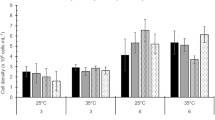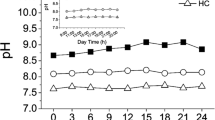Abstract
Gracilariopsis lemaneiformis was cultured at different temperatures (15, 23, and 31 °C) under CO2 levels of 390 and 800 μL L−1 for 2 weeks, to elucidate the physiological and biochemical responses to variable temperature at elevated CO2 in this marine-cultivated species in China. The relative growth rates (RGR) was highest at 23 °C among the three temperature levels. Photosynthetic pigments (Chl a, Car, PB) were CO2 independent, but the 15 °C-grown algae were always larger. In contrast, the Chl a/PB ratios increased with increasing growth temperature. The maximum relative electron transport rates (rETRm) presented a strong potential to acclimate lower growth temperature. Moreover, the photosynthetic acclimation was enhanced by elevated CO2. Adjustments of Chl a fluorescence and antioxidant enzymes were responsible for this photosynthetic acclimation strategy. A rise of Chl a fluorescence (α, E k, qP, and Y (II)) and superoxide dismutase (SOD) and peroxidase (POD) activities was observed when growth temperature decreased. These changes indicate a strong defense capability for reactive oxygen species (ROS) and a crucial role of elevated CO2 during long-term photosynthetic acclimation. Additionally, a decrease of the maximal quantum yield (Fv/Fm) was found when measured at 39 °C. Up-regulation of thermal dissipation was observed, as NPQ significantly increased at 31 °C at both CO2 levels.





Similar content being viewed by others
References
Alscher RG, Erturk N, Heath LS (2002) Role of superoxide dismutases (SODs) in controlling oxidative stress in plants. J Exp Bot 53:1331–1341
Apel K, Hirt H (2004) Reactive oxygen species: metabolism, oxidative stress, and signal transduction. Annu Rev Plant Biol 55:373–399
Beer S, Eshel A (1985) Determining phycoerythrin and phycocyanin concentrations in aqueous crude extracts of red algae. Mar Freshw Res 36:785–792
Cakmak I, Horst WJ (1991) Effect of aluminium on lipid peroxidation, superoxide dismutase, catalase, and peroxidase activities in root tips of soybean (Glycine max). Physiol Plantarum 83:463–468
Cosgrove J, Borowitzka MA (2011) Chlorophyll fluorescence terminology: an introduction. In: Suggett DJ, Prásil O, Borowitzka MA (eds) Chlorophyll a fluorescence in aquatic sciences: methods and applications. Springer, Dordrecht, pp. 1–17
Davison IR (1991) Environmental effects on algal photosynthesis: temperature. J Phycol 27:2–8
Davison IR, Pearson GA (1996) Stress tolerance in intertidal seaweeds. J Phycol 32:197–211
Davison IR, Greene R, Podolak E (1991) Temperature acclimation of respiration and photosynthesis in the brown alga Laminaria saccharina. Mar Biol 110:449–454
Eggert A, Visser RJW, Van Hasselt PR, Breeman AM (2006) Differences in acclimation potential of photosynthesis in seven isolates of the tropical to warm temperate macrophyte Valonia utricularis (Chlorophyta). Phycologia 45:546–556
Enríquez S, Borowitzka MA (2011) The use of the fluorescence signal in studies of seagrasses and macroalgae. In: Suggett DJ, Prásil O, Borowitzka MA (eds) Chlorophyll a fluorescence in aquatic sciences: methods and applications. Springer, Dordrecht, pp. 187–208
Fabry VJ, Seibel BA, Feely RA, Orr JC (2008) Impacts of ocean acidification on marine fauna and ecosystem processes. J Mar Sci 65:414–432
Gordillo FJ, Niell FX, Figueroa FL (2001) Non-photosynthetic enhancement of growth by high CO2 level in the nitrophilic seaweed Ulva rigida C. Agardh (Chlorophyta). Planta 213:64–70
Heath RL, Packer L (1968) Photoperoxidation in isolated chloroplasts: I. Kinetics and stoichiometry of fatty acid peroxidation. Arch Biochem Biophys 125:189–198
Hodgson RA, Raison JK (1991) Superoxide production by thylakoids during chilling and its implication in the susceptibility of plants to chilling-induced photoinhibition. Planta 183:222–228
Horton P, Ruban A, Walters R (1996) Regulation of light harvesting in green plants. Annu Rev Plant Biol 47:655–684
Huner NP, Öquist G, Sarhan F (1998) Energy balance and acclimation to light and cold. Trends Plant Sci 3:224–230
Jahns P, Latowski D, Strzalka K (2008) Mechanism and regulation of the violaxanthin cycle: the role of antenna proteins and membrane lipids. Biochim Biophys Acta 1787:3–14
Kübler JE, Davison IR (1995) Thermal acclimation of light-use characteristics of Chondrus crispus (Rhodophyta). Eur J Phycol 30:189–195
Mishra S, Srivastava S, Tripathi R, Kumar R, Seth C, Gupta D (2006) Lead detoxification by coontail (Ceratophyllum demersum L.) involves induction of phytochelatins and antioxidant system in response to its accumulation. Chemosphere 65:1027–1039
Muñoz MJ, García MF, García RP, Arribas E, Tudela J, Garcia CF, Rodriguez LJ (2009) Enzymatic and chemical oxidation of trihydroxylated phenols. Food Chem 113:435–444
Rossa MM, de Oliveira MC, Okamoto OK, Lopes PF, Colepicolo P (2002) Effect of visible light on superoxide dismutase (SOD) activity in the red alga Gracilariopsis tenuifrons (Gracilariales, Rhodophyta). J Appl Phycol 14:151–157
Sabine CL, Feely RA (2007) The oceanic sink for carbon dioxide. In: Reay D, Hewitt N, Grace J, Smith K (eds) Greenhouse gas sinks. CABI Publishing, Oxfordshire, pp. 31–49
Shiu CT, Lee TM (2005) Ultraviolet-B-induced oxidative stress and responses of the ascorbate–glutathione cycle in a marine macroalga Ulva fasciata. J Exp Bot 56:2851–2865
Staehr PA, Wernberg T (2009) Physiological responses of Ecklonia radiata (Laminariales) to a latitudinal gradient in ocean temperature. J Phycol 45:91–99
Suárez-Álvarez S, Gómez-Pinchetti JL, García-Reina G (2012) Effects of increased CO2 levels on growth, photosynthesis, ammonium uptake and cell composition in the macroalga Hypnea spinella (Gigartinales, Rhodophyta). J Appl Phycol 24:815–823
Torres PB, Chow F, Santos DYAC (2015) Growth and photosynthetic pigments of Gracilariopsis tenuifrons (Rhodophyta, Gracilariaceae) under high light in vitro culture. J Appl Phycol 27:1243–1251
Trevathan-Tackett SM, Kelleway J, Macreadie PI, Beardall J, Ralph P, Bellgrove A (2015) Comparison of marine macrophytes for their contributions to blue carbon sequestration. Ecology 96:3043–3057
Tukaj Z, Aksmann A (2007) Toxic effects of anthraquinone and phenanthrenequinone upon Scenedesmus strains (green algae) at low and elevated concentration of CO2. Chemosphere 66:480–487
Wang Y, Feng Y, Wang H, Zhong M, Chen W, Du H (2016) Physiological and proteomic analyses of two Gracilaria lemaneiformis strains in response to high-temperature stress. J Appl Phycol 28:1847–1858
Wang WJ, Wang GC, Gao ZQ, Lin XZ, Xu P (2007) Characterization of Gracilaria lemaneiformis Bory (Gracilariaceae, Rhodophyta) cultivars in China using the total soluble proteins and RAPD analysis. Bot Mar 50:177–184
Wellburn AR (1994) The spectral determination of chlorophylls a and b, as well as total carotenoids, using various solvents with spectrophotometers of different resolution. J Plant Physiol 144:307–313
Wernberg T, Smale DA, Thomsen MS (2012) A decade of climate change experiments on marine organisms: procedures, patterns and problems. Glob Change Biol 18:1491–1498
Yang YF, Fei XG, Song JM, Hu HY, Wang GC, Chung IK (2006) Growth of Gracilaria lemaneiformis under different cultivation conditions and its effects on nutrient removal in Chinese coastal waters. Aquaculture 254:248–255
Yin XL, Jiang L, Song NH, Yang H (2008) Toxic reactivity of wheat (Triticum aestivum) plants to herbicide isoproturon. J Agric Food Chem 56:4825–4831
Yong YS, Yong WTL, Anton A (2013) Analysis of formulae for determination of seaweed growth rate. J Appl Phycol 25:1831–1834
Young A, Frank H (1996) Energy transfer reactions involving carotenoids: quenching of chlorophyll fluorescence. J Photochem Photobiol B 36:3–15
Yu J, Yang YF (2008) Physiological and biochemical response of seaweed Gracilaria lemaneiformis to concentration changes of N and P. J Exp Mar Biol Ecol 367:142–148
Zhou W, Zhao D, Lin X (1997) Effects of waterlogging on nitrogen accumulation and alleviation of waterlogging damage by application of nitrogen fertilizer and mixtalol in winter rape (Brassica napus L.). J Plant Growth Regul 16:47–53
Zou D, Gao K (2009) Effects of elevated CO2 on the red seaweed Gracilaria lemaneiformis (Gigartinales, Rhodophyta) grown at different irradiance levels. Phycologia 48:510–517
Zou D, Gao K (2013) Thermal acclimation of respiration and photosynthesis in the marine macroalga Gracilaria lemaneiformis (Gracilariales, Rhodophyta). J Phycol 49:61–68
Zou D, Gao K (2014a) The photosynthetic and respiratory responses to temperature and nitrogen supply in the marine green macroalga Ulva conglobata (Chlorophyta). Phycologia 53:86–94
Zou D, Gao K (2014b) Temperature response of photosynthetic light-and carbon-use characteristics in the red seaweed Gracilariopsis lemaneiformis (Gracilariales, Rhodophyta). J Phycol 50:366–375
Zubia M, Freile-Pelegrín Y, Robledo D (2014) Photosynthesis, pigment composition and antioxidant defences in the red alga Gracilariopsis tenuifrons (Gracilariales, Rhodophyta) under environmental stress. J Appl Phycol 26:2001–2010
Acknowledgments
This study was supported by the National Natural Science Foundation of China (No. 41276148 and U1301235) and Science and Technology Planning Project of Guangdong (No. 2015 A020216004).
Author information
Authors and Affiliations
Corresponding author
Rights and permissions
About this article
Cite this article
Liu, C., Zou, D., Yang, Y. et al. Temperature responses of pigment contents, chlorophyll fluorescence characteristics, and antioxidant defenses in Gracilariopsis lemaneiformis (Gracilariales, Rhodophyta) under different CO2 levels. J Appl Phycol 29, 983–991 (2017). https://doi.org/10.1007/s10811-016-0971-8
Received:
Revised:
Accepted:
Published:
Issue Date:
DOI: https://doi.org/10.1007/s10811-016-0971-8




